Participatory Rehabilitation of Dry Valleys [أثيوبيا]
- تاريخ الإنشاء:
- تحديث:
- جامع المعلومات: GERBA LETA
- المحررون: Torben Helbig, Noel Templer
- المراجعون: William Critchley, Rima Mekdaschi Studer
Kaqayb Galka Dadwayne
approaches_6718 - أثيوبيا
عرض الأقسام
توسيع الكل طي الكل1. معلومات عامة
1.2 تفاصيل الاتصال بالأشخاص الرئيسيين لمصدر المعلومات والمؤسسات المعنية بتقييم وتوثيق النهج
الشخص (الأشخاص) الرئيسي لمصدر المعلومات
متخصص في الإدارة المستدامة للأراضي:
Omer Ahmed
+251910061493
ahmdomr1954@gmail.com
Natural Resource Department of Somali Regional State Bureau of Agriculture
Somali Regional State, JigJiga
أثيوبيا
اسم المشروع الذي سهّل توثيق/تقييم النهج (إذا كان ذلك على صلة)
Soil protection and rehabilitation for food security (ProSo(i)l)اسم المؤسسة (المؤسسات) التي سهلت توثيق/تقييم النهج (إذا كان ذلك على صلة)
Alliance Bioversity and International Center for Tropical Agriculture (Alliance Bioversity-CIAT) - كينيا1.3 الشروط المتعلقة باستخدام البيانات الموثقة من خلال WOCAT
متى تم تجميع البيانات (ميدانيا)؟:
22/03/2023
يوافق جامع المعلومات والشخص (لاشخاص) الرئيسي لمصدر المعلومات على الشروط المتعلقة باستخدام البيانات الموثقة من خلال WOCAT:
نعم
1.4 المراجع الخاصة باستبيان(استبيانات) تقنيات الإدارة المستدامة للأراضي
2. وصف نهج الإدارة المستدامة للأراضي
2.1 وصف موجز للنهج
Participatory rehabilitation and productive use of dry valleys is an approach employed to rehabilitate degraded and degradable land. It is operationalised through the Lowland Soil Rehabilitation Project with local development partners from kebele, district, regional agricultural bureaus, and other relevant stakeholders.
2.2 وصف تفصيلي للنهج
وصف تفصيلي للنهج:
Participatory rehabilitation of degraded and degradable dry valleys engages the community at the grassroots through consultation. It is operationalised through the Lowland Soil Rehabilitation Project with local development partners from kebele, district, regional agricultural bureaus, and other relevant stakeholders.
Technical experts from the district and region are involved in reconnaissance, observation and joint selection of the intervention sites. The team conduct a survey, then profile and design the technologies required, along with the project engineer. The approach optimises the participation of the community and agricultural actors, allowing the development of a sense of ownership and accountability through training and awareness-creation exercises. In turn this encourages them to take care of and maintain the structures.
This approach combines top-down and bottom-up methods. At the grassroots, the local agropastoral communities are mobilized by local extension agents and made aware about the SLM intervention that the project and partners strive to put in place – including the physical structures in the farmers' fields and communal lands. The procedures include a site visit, a survey/ observation, and the identification of the intervention site based on the specific topographic features and drainage system of the catchment. Then, detailed field data is collected and a profile analysis is made to develop the design and get approval after stakeholders’ consultation and review of the details of the implementation design. The approach is complemented by satellite imagery and ground truthing. Following this, the next stage is identification of masonry experts, provision of training, and supply of construction materials and tools. Building the masonry works involves both skilled and unskilled labour.
The woreda NRM expert (focal person) facilitate the process at the grassroots through the development agents. The community gives their consent and support to the objectives of the project implementation. Therefore, they are involved in local decision-making and overseeing the technology that is being put in place.
The agropastoral community is the end user and benefits from the positive consequences of the intervention which is a result of better management of soil and water for productive uses of the dry valley. However, because of a lack of awareness, and the agropastoralists conventional livelihoods practice traveling with their livestock, there is a lack of participation in the day-to-day implementation activities. That limits their active contribution in implementation. Of course, local elders value the consultative experience which confirms a sense of self-worth and acknowledges their role in ownership of the land and as the ultimate decision-maker for development intervention operating in their areas.
2.3 صور عن النهج
ملاحظات عامة بخصوص الصور:
Photos (undated) obtained from project staff of community engagement taking place at the beginning of the project implementation.
2.4 فيديوهات عن النهج
تعليقات، وصف موجز:
Video of the approach was not documented.
2.5 البلد/المنطقة/المواقع التي تم تطبيق النهج فيها
البلد:
أثيوبيا
المنطقة/الولاية/المحافظة:
Somali
مزيد من التفاصيل حول الموقع:
Amadle kebele, South Jijiga district
Map
×2.6 تواريخ بدء وإنهاء تنفيذ النهج
أشر إلى سنة البدء:
2021
التعليقات:
The project termination date is not indicated.
2.7 نوع النهج
- قائم على مشروع/برنامج
2.8 الغايات/الأهداف الرئيسية للنهج
To engage the community and other stakeholders in making participatory decisions on the rehabilitation of the dry valley.
2.9 الظروف التي تمكن أو تعيق تنفيذ التقنية/التقنيات المطبقة بموجب النهج
توفر/الوصول إلى الموارد والخدمات المالية
- تمكين/تمكيني
Access to finance promotes intensive awareness creation and participation of the community to implement the technology at a larger scale. Also, it allows supporting the maintenance and other follow on actions that ensure sustainability.
الإطار المؤسساتي
- تمكين/تمكيني
Setting up the local institution such as an agropastoralist group enables the effective implementation of dry valley rehabilitation technologies/practices.
التعاون/التنسيق بين الجهات الفاعلة
- تمكين/تمكيني
Coordination of actors enables the identification of useful actors and cross-fertilize experiential knowledge for documentation and further uses. Also, it enables acknowledgment of the contribution of different actors.
المعرفة حول الإدارة المستدامة للأراضي، والوصول إلى الدعم الفني
- تمكين/تمكيني
Having SLM knowledge enables efficient and effective implementation of dry valley rehabilitation technologies.
عبء العمل، توفر القوى العاملة
- تمكين/تمكيني
Labour in the agropastoralist area is the limiting factor for the effective implementation of SLM practices. Therefore, the availability of labor or manpower is pivotal for the proper implementation of the SLM.
3. المشاركة وأدوار الأطراف المعنية
3.1 أصحاب المصلحة المعنيون بالنهج وأدوارهم
- مستخدمو الأراضي المحليون/المجتمعات المحلية
Agropastoralist.
Participatory planning and decision making, sources casual laborer and oversee the technologies/practices.
- متخصصون في الإدارة المستدامة للأراضي / مستشارون زراعيون
Natural Resource Management experts.
Facilitate stakeholders' participation, provide technical support, and backstopping services, and monitor the development during and after the implementation of the technologies.
- القطاع الخاص
Contractor to perform the engineering works.
Building/constructing the physical structures.
- GIZ project
GIZ (bilateral cooperation) projects.
Provide financial and technical support to the government partner organizations to promote the proper implementation of the rehabilitation of dry valley.
3.2 انخراط مستخدمي الأراضي المحليين/المجتمعات المحلية في المراحل المختلفة للنهج
| انخراط مستخدمي الأراضي المحليين/المجتمعات المحلية | حدد من شارك وصف الأنشطة | |
|---|---|---|
| المبادرة/التحفيز | تفاعلي | Agropastoralists involve in allowing peers to understand SLM-related intervention. |
| التخطيط | تفاعلي | Land users involve in participatory planning and decision-making exercise. |
| التنفيذ | الدعم الخارجي | Skilled and unskilled laborers are sources from neighboring urban areas and the intervention kebeles. |
| الرصد/التقييم | الدعم الخارجي | SLM experts and extension agents support in monitoring and evaluation of the intervention activities. |
3.3 مخطط التدفق (إذا كان متاحًا)
الوصف:
The sketch describe the process of implementing Participatory Rehabilitation of Dry Valleys.
المؤلف:
Gerba Leta
3.4 اتخاذ القرار بشأن اختيار تقنية/تقنيات الإدارة المستدامة للأراضي
حدد من الذي قرر اختيار التقنية/التقنيات التي سيتم تنفيذها:
- متخصصون في الإدارة المستدامة للأراضي بشكل أساسي، بعد التشاور مع مستخدمي الأراضي
اشرح:
The communities are consulted, however, selection decision is made by the SLM experts of the partner organizations in consultation with the project SLM specialists.
حدد على أي أساس تم اتخاذ القرارات:
- تقييم المعرفة الموثقة جيدًا بشأن الإدارة المستدامة للأراضي(اتخاذ القرارات القائمة على الأدلة)
4. الدعم الفني وبناء القدرات وإدارة المعرفة
4.1 بناء القدرات/التدريب
هل تم تقديم التدريب لمستخدمي الأراضي / الأطراف المعنيين الآخرين؟:
نعم
حدد من تم تدريبه:
- موظفون ميدانيون/ مستشارون
شكل التدريب:
- في العمل
- اجتماعات عامة
شكل التدريب:
- Masonry workers
المواضيع المغطاة:
Dry Land Rehabilitation and Produce Use of the rehabilitated land. Basically, the training is on the SLM practices which are suitable for agropastoralist areas with special emphasis on the physical structure.
التعليقات:
SLM experts from partner organizations and masonry workers were trained to assist in the implementation of SLM practices for dry land rehabilitation.
4.2 خدمة استشارية
هل يملك مستخدمو الأراضي وصولا إلى خدمة استشارية؟:
نعم
حدد ما إذا كانت الخدمة الاستشارية متوفرة:
- في حقول مستخدمي الأراضي
وصف/تعليقات:
Advisory services related to SLM are infrequently given. As the agropastoralists are mobile looking for feed and water, particularly during the dry period, advisory services have not been provided on regular basis.
4.3 تعزيز المؤسسات (التطوير التنظيمي)
هل تم إنشاء أو تعزيز مؤسسات من خلال هذا النهج؟:
- نعم، قليلا
حدد المستوى (المستويات) التي تم فيها تعزيز أو إنشاء المؤسسات:
- محلي
صف المؤسسة والأدوار والمسؤوليات والأعضاء وما إلى ذلك.
Stakeholders from government and bilateral organization (project) do make ad hoc meeting during planning and evaluation, this brings actors together but need to establish a sustainable institution that stands on its own and can be working beyond the project's lifetime. Particularly, a land users (agropastoralist) group is essential to oversee the technology placed on their land so that sustainability of the intervention can be ensured.
حدد نوع الدعم:
- مالي
- بناء القدرات/التدريب
- معدات
اعط مزيدا من التفاصيل:
The equipment refers to the technical tools that can be used by the partner experts - but not farm tools. The latter is expected during which the agropastoralist resumes the productive use of the rehabilitated land which is currently in the initial years of implementation and not yet associated with the productive uses of it.
4.4 الرصد والتقييم
هل يشكل الرصد والتقييم جزءا من النهج؟:
نعم
التعليقات:
The monitoring and evaluation are part of the project implementation that enables the implementers to track the development and engage the end users to enable them to sense the benefits. The land users started to benefit from the structure such as fetching drinking water both for human and their livestock, though, it is an indirect benefit from the intervention.
إذا كانت الإجابة بنعم، فهل من المقصود استخدام هذه الوثائق للمراقبة والتقييم؟:
نعم
4.5 البحوث
هل كانت البحوث جزءًا من النهج؟:
كلا
5. التمويل والدعم المادي الخارجي
5.1 الميزانية السنوية لمكون الإدارة المستدامة للأراضي في النهج المذكور
إذا لم تكن الميزانية السنوية الدقيقة معروفة، قم بالإشارة إلى نطاقها:
- 10,0000-2,000
التعليقات (على سبيل المثال المصادر الرئيسية للتمويل/الجهات المانحة الرئيسية):
No specific data on budget allocation for SLM at the district level. However, Local Subsidy Contract (LSC) was used to assist the woreda implement and follow-up the development of the intervention.
5.2 الدعم المالي/المادي المقدم لمستخدمي الأراضي
هل حصل مستخدمو الأراضي على دعم مالي/ مادي لتنفيذ التقنية/ التقنيات؟:
كلا
5.3 إعانات لمدخلات محددة (بما في ذلك العمالة)
التعليقات:
There is no subsidy system supplied to the land users. Labor contribution is on a pay basis in cash. As the area is characterized by food insecurity and drought-prone by virtue, free labor is not expected. Basically, skilled and unskilled labor imported from the nearby town. Thus, it is impossible to assign this role to the land users.
5.4 الائتمان
هل تم توفير ائتمان في إطار نهج أنشطة الإدارة المستدامة للأراضي؟:
كلا
5.5 حوافز أو وسائل أخرى
هل تم استخدام حوافز أو أدوات أخرى لتشجيع تنفيذ تقنيات الإدارة المستدامة للأراضي؟:
كلا
6. تحليل الأثر والتصريحات الختامية
6.1 آثار النهج
هل ساهم النهج في تمكين مستخدمي الأراضي المحليين وتحسين مشاركة الأطراف المعنية؟:
- لا
- نعم، قليلا
- نعم، باعتدال
- نعم، إلى حد كبير
Local land users consulted and informed regarding the benefits of SLM for the degraded and potentially degradable lands to ensure rehabilitation and its productive use. This may give motivation and a sense of self-worth as land owner.
هل مكّن النهج من اتخاذ القرارات المبنية على الأدلة؟:
- لا
- نعم، قليلا
- نعم، باعتدال
- نعم، إلى حد كبير
Beyond the approach, the land users can learn from the actual function of the technologies.
هل ساعد النهج مستخدمي الأراضي على تنفيذ وصيانة تقنيات الإدارة المستدامة للأراضي؟:
- لا
- نعم، قليلا
- نعم، باعتدال
- نعم، إلى حد كبير
Consultation with the land users motivates them to build trust in the intervention.
هل نجح النهج في تحسين التنسيق والتنفيذ الفعال من حيث التكلفة لأنشطة الإدارة المستدامة للأراضي؟:
- لا
- نعم، قليلا
- نعم، باعتدال
- نعم، إلى حد كبير
In the long run, it can assist land users mobilize casual laborers.
هل نجح النهج في تعبئة/تحسين الوصول إلى الموارد المالية لتنفيذ الإدارة المستدامة للأراضي؟:
- لا
- نعم، قليلا
- نعم، باعتدال
- نعم، إلى حد كبير
هل أدى النهج إلى تحسين معرفة وقدرات مستخدمي الأراضي على تنفيذ الإدارة المستدامة للأراضي؟:
- لا
- نعم، قليلا
- نعم، باعتدال
- نعم، إلى حد كبير
The approach creates an opportunity for land users to engage in the initial implementation process through which their awareness is raised.
هل أدى النهج إلى تحسين معرفة وقدرات الأطراف المعنية الأخرى؟:
- لا
- نعم، قليلا
- نعم، باعتدال
- نعم، إلى حد كبير
Through stakeholders meeting and training opportunities created by the project.
هل ساهم النهج في بناء/تعزيز المؤسسات والتعاون بين الأطراف المعنية؟:
- لا
- نعم، قليلا
- نعم، باعتدال
- نعم، إلى حد كبير
It builds collaboration between stakeholders.
هل ساهم النهج في التخفيف من حدة الصراعات؟:
- لا
- نعم، قليلا
- نعم، باعتدال
- نعم، إلى حد كبير
هل ساهم النهج في تمكين الفئات المحرومة اجتماعيا واقتصاديا؟:
- لا
- نعم، قليلا
- نعم، باعتدال
- نعم، إلى حد كبير
Involve them in the awareness creation training.
هل أدى النهج إلى تحسين المساواة بين الجنسين وتمكين النساء والفتيات؟:
- لا
- نعم، قليلا
- نعم، باعتدال
- نعم، إلى حد كبير
Women are involved in the community meeting and/or consultation. Also benefited from the technology as it creates the opportunity to fetch drinking still water closer to their residence.
هل شجع النهج الشباب/الجيل القادم من مستخدمي الأراضي على الانخراط في الإدارة المستدامة للأراضي؟:
- لا
- نعم، قليلا
- نعم، باعتدال
- نعم، إلى حد كبير
It provides knowledge to the young generation through exposure to evidence based intervention.
هل أدى النهج إلى تحسن في مسائل حيازة الأراضي / حقوق المستخدمين التي أعاقت تنفيذ تقنيات الإدارة المستدامة للأراضي؟:
- لا
- نعم، قليلا
- نعم، باعتدال
- نعم، إلى حد كبير
هل أدى هذا النهج إلى تحسين الأمن الغذائي / تحسين التغذية؟:
- لا
- نعم، قليلا
- نعم، باعتدال
- نعم، إلى حد كبير
The technology implemented using the participatory approach believed to rehabilitate degraded lands and enhances productive use of the rehabilitated lands for growing various crops, and supply feeds to the livestock.
هل أدى النهج إلى تحسين الوصول إلى الأسواق؟:
- لا
- نعم، قليلا
- نعم، باعتدال
- نعم، إلى حد كبير
هل أدى النهج إلى تحسين الوصول إلى المياه والصرف الصحي؟:
- لا
- نعم، قليلا
- نعم، باعتدال
- نعم، إلى حد كبير
The technology implemented using this approach creates land users temporal access to still as well as groundwater regardless.
هل أدى النهج إلى استخدام طاقة/ مصادر طاقة أكثر استدامة؟:
- لا
- نعم، قليلا
- نعم، باعتدال
- نعم، إلى حد كبير
هل أدى النهج إلى تحسين قدرة مستخدمي الأراضي على التكيف مع التغيرات المناخية/الظواهر المناخية المتطرفة والتخفيف من الكوارث المرتبطة بالمناخ؟:
- لا
- نعم، قليلا
- نعم، باعتدال
- نعم، إلى حد كبير
In the future, when the productive use of dry valley is effected, post the rehabilitation efforts, land users certainly develop an adaptation to climate change and associated disasters through participatory approach.
هل أدى النهج إلى توفير فرص عمل ودخل؟:
- لا
- نعم، قليلا
- نعم، باعتدال
- نعم، إلى حد كبير
It improves generation of income from the production of food and feed crops.
6.2 المحفز الرئيسي لقيام مستخدمي الأراضي بتنفيذ الإدارة المستدامة للأراضي
- زيادة الإنتاج
Food crops and livestock feed production are increased as the technology reduces the intensity and effects of erosion and conserves soil and water.
- زيادة الربح (القدرة)، وتحسين نسبة التكلفة إلى العائد
Over time, the technology/approach improves the productive use of rehabilitated land for crop and livestock production that increases overall benefits.
- الحد من تدهور الأراضي
As the structure stops heavy movement of the soil with runoff, it absolutely reduces the rate or speed of erosion and land degradation.
- الحد من مخاطر الكوارث
The water harvested and spread on the farmland reduces the risks of crop failure and can be used for spate irrigation. Furthermore, the structure reduces the speed of runoff and retain the top soil moving away.
- تعزيز المعرفة والمهارات في مجال الإدارة المستدامة للأراضي
The exposure to training and collective action and lesson learnt from the outcome of the implementation enhance knowledge and skills of the land users and experts.
6.3 استدامة أنشطة النهج
هل يمكن لمستخدمي الأراضي المحافظة على استدامة ما تم تنفيذه من خلال النهج (بدون دعم خارجي)؟:
- غير مؤكد
إذا كان الجواب لا أو غير متأكد، حدد ذلك وعلق عليه:
As maintenance of the structure such as in cases of check dam is resource demanding, it is less likely for the land users to maintain/repair on their own. Rather early combining the physical structure by biological barriers or perennial forage or tree planation may ensure sustainability of the technology/land use. Furthermore, it demands time and labor from the agro-pastoralists.
6.4 نقاط قوة/مزايا النهج
| نقاط القوة/ المزايا/ الفرص من وجهة نظر مستخدمي الأراضي |
|---|
| Creates stakeholders awareness on SLM, and productive use of rehabilitated dry valley. |
| Improves coordination between agricultural actors in line offices, and other stakeholders collective action. |
| Enhances participatory decision making on the development and use of the rehabilitated lands. |
| نقاط القوة/ المزايا/ الفرص من وجهة نظر جامع المعلومات أو غيره من الاشخاص الرئيسيين لمصدر المعلومات |
|---|
| It creates evidence based lesson learning to replicate similar practices across the region. |
| It improves SLM implementation capacity of the development partners (agricultural offices) and the land users at local level. |
| It encourages the government respective department to allocate matching fund for SLM operationalized by development partners. |
6.5 نقاط الضعف/ العيوب في المنهج وطرق التغلب عليها
| نقاط الضعف/ المساوىء/ المخاطر من وجهة نظر مستخدم الأراضي | كيف يمكن التغلب عليها؟ |
|---|---|
| Time and energy/labor demanding to integrate efforts of experts from different organizations. | Nurture proper joint planning for collective action. |
| Shortage of financial and material resources to put the structure in place. | Find and generate sources of resources and promote efficient use of the available budget. |
| Improper participation of stakeholders (dropout of experts) | Enforce participation through adopting binding by-laws to all. |
| نقاط الضعف/ المساوىء/ المخاطر من وجهة نظر جامع المعلومات أو غيره من الاشخاص الرئيسيين لمصدر المعلومات | كيف يمكن التغلب عليها؟ |
|---|---|
| Recurrent droughts displace the land users while looking for water and feed to their animals. | Ensure representation to the community, and assess enabling environment that reduce temporal displacement of the land users. |
| Relatively low participation of the land users in the conception and implementation of the approach as well as the technology intended to rehabilitate the dry valley. | Promote land users participation through intensive capacity building and awareness creation by gender and various categories of the community. |
| Lack of forming agro-pastoralist group who are believed to share knowledge, skills and labor for collective oversee and maintenance of the technology when damage is encountered. | Promote the development of a local institution that allows not only for the use of the land but also to oversee the gaps, report the issues, and involve in participatory fixing activities. |
7. المراجع والروابط
7.1 طرق جمع/مصادر المعلومات
- زيارات ميدانية، مسوحات ميدانية
Three individuals
- مقابلات مع المتخصصين/الخبراء في الإدارة المستدامة للأراضي
Four
7.2 المراجع للمنشورات المتاحة
العنوان، المؤلف، السنة، النظام القياسي الدولي لترقيم الكتب ISBN:
Problems and landscape approach for ecological rehabilitation in the dry valleys of Southwest China. Dong, Y. & Liu, S. (Undated)
متاح من أين؟كم التكلفة؟:
https://www.researchgate.net/profile/Shiliang-Liu-5/publication/221354340_Problems_and_Landscape_Approach_for_Ecological_Rehabilitation_in_the_Dry_Valleys_of_Southwest_China/links/574129be08ae9ace84160bec/
7.3 روابط للمعلومات ذات الصلة المتوفرة على الإنترنت
العنوان/الوصف:
Supporting local planning and the importance of mapping
عنوان الرابط URL:
https://dream.vandermeijde.net/wp-content/uploads/2022/11/220620_planningandmapping_Roden.pdf
الروابط والوحدات المواضيعية
توسيع الكل طي الكلالروابط
لا يوجد روابط
الوحدات المواضيعية
لا يوجد وحدات مواضيعية






